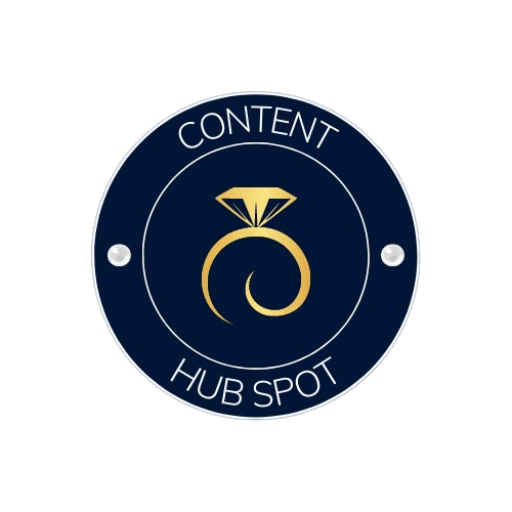In this blog post, we’ll explore the 7 steps of content marketing that make up a comprehensive content marketing strategy. Whether you’re new to content marketing or looking to refine your existing tactics, understanding and implementing these steps can significantly enhance your content’s effectiveness and impact.
So, let’s dive into the world of content marketing and uncover the 7 steps of content marketing.
The 7 steps of content marketing
Step 1: Define Your Content Marketing Goals
Defining your content marketing goals is a crucial first step in creating an effective content marketing strategy. Your goals will serve as a roadmap and help you measure the success of your efforts in content marketing.
Some Common Content Marketing Goals and How You Can Achieve It

Here are some common content marketing goals and insights on each:
Increase Website Traffic: Many businesses aim to drive more visitors to their websites.
How You Can Achieve It: This goal can be achieved through SEO-optimized blog posts, social media promotion, and guest posting on relevant websites. Tools like Google Analytics can help you track your website traffic.
Generate Leads: Content marketing can be a powerful lead generation tool.
How You Can Achieve It: You can create downloadable resources like ebooks, whitepapers, or webinars in exchange for contact information. This allows you to build a list of potential customers.
Boost Brand Awareness: If your goal is to make your brand more recognizable, focus on creating high-quality, shareable content.
How You Can Achieve It: Engage with your audience on social media and encourage them to share your content. Consistency in branding and messaging is key.
Establish Authority and Thought Leadership: Becoming an authority in your industry can set you apart from competitors.
How You Can Achieve It: Write in-depth, well-researched articles, and participate in industry discussions. Over time, people will come to trust your expertise.
Improve Customer Retention: Content isn’t just for acquiring new customers; it can also help retain existing ones.
How You Can Achieve It: Create content that adds value for your current customers, such as how-to guides, product tutorials, and updates on new features or offerings.
Educate Your Audience: Informative content can help educate your audience about industry trends, best practices, or how to use your products/services effectively. This positions your brand as a helpful resource.
Enhance SEO Ranking: Content plays a significant role in SEO.
How You Can Achieve It: By consistently publishing high-quality, relevant content and optimizing it for search engines, you can improve your website’s visibility in search results.
Measure Customer Satisfaction: Engagement metrics, such as likes, shares, comments, and social media interactions, can indicate how well your content resonates with your audience.
How You Can Achieve It: Collect feedback through surveys, reviews, and social media comments to gauge how satisfied your customers are. Use this information to create content that addresses their needs and concerns.
These are common content marketing goals and more goals like-Support Product Launches, Build Partnerships, Engage Your Audience etc that help you to enhance content marketing and to create effective content marketing strategy.
Remember that your Content marketing goals should be specific, measurable, achievable, relevant, and time-bound (SMART). Regularly assess your progress, adjust your strategy as needed, and be prepared to adapt to changes in your industry and audience preferences. Your content marketing goals should align with your overall business objectives and evolve over time as your business grows.
Step 2: Understand Your Target Audience
Understanding your target audience is a fundamental aspect of successful content marketing. By knowing your audience well, you can create content that resonates with them, addresses their needs and interests, and ultimately drives engagement and conversions.
What is a target audience?
In marketing and advertising, a target audience refers to a specific group of people or organizations that a business aims to reach with its products, services, or marketing messages.
How to understand target audience
Keyword Research: By doing keyword research it helps to discover the words and phrases your audience uses when searching for information related to your industry or products. This can help you create content that ranks well in search engines.
Competitor Analysis: Study your competitors and their audiences. By doing competitor analysis you can also understand your audiences(persona, problem, requirement, Audience capacity and more). Identify gaps in their content strategies that you can fill or areas where you can differentiate yourself.
Analyze Website and Social Media Analytics: Review your website’s analytics to understand who is visiting your site, what content they are consuming, and how they are interacting with it. Social media analytics can provide insights into your followers’ behavior and interests.
These are the basic or easy methods to understand the target audience without giving the money.
Step 3: Content marketing Strategy and Planning
Content marketing strategy and planning are critical and time-consuming components of a successful content marketing effort. They involve the development of a well-thought-out approach to creating, distributing, and managing content to achieve specific marketing goals.

The steps to create the content strategy and planning
Here are the key steps to create the content strategy and planning:
1. Define Your Goals: Start by clarifying your content marketing objectives. Are you looking to increase website traffic, generate leads, boost brand awareness, or achieve other goals? Ensure your goals are specific, measurable, achievable, relevant, and time-bound (SMART).
2. Know Your Audience: As mentioned earlier, understanding your target audience is crucial. Create detailed personas to guide your content creation efforts. Know their pain points, interests, and preferences.
3. Content Audit: Conduct an audit of your existing content if applicable. Identify what content you have, its performance, and any gaps in your content library. This helps in planning future content.
4. Content Ideation: Brainstorm content ideas that align with your goals and audience’s interests. Consider different content formats such as blog posts, videos, infographics, podcasts, webinars, and more.
5. Content Calendar: Develop a content calendar that outlines what content will be created, when it will be published, and which team members are responsible for each piece. This calendar helps in maintaining consistency.
6. Keyword Research: If SEO is a part of your strategy (which it often should be), perform keyword research to identify relevant keywords and phrases that your audience searches for. Incorporate these into your content planning.
7. Content Creation: Create high-quality, valuable content that speaks to your audience’s needs. Focus on providing solutions, answering questions, and offering unique insights.
8. Distribution Plan: Determine how you will distribute your content to reach your audience. This may involve sharing on social media, email marketing, guest posting, or other channels. Consider the timing and frequency of distribution.
9. Promotion and Outreach: Don’t rely solely on organic reach. Actively promote your content through paid advertising, influencer collaborations, and outreach to industry publications or bloggers.
10. Measurement and Analytics: Establish key performance indicators (KPIs) to measure the success of your content. Common KPIs include website traffic, conversion rates, social shares, and engagement metrics. Use tools like Google Analytics to track and analyze performance.
11. Feedback and Iteration: Continually assess the performance of your content and gather feedback from your audience. Use this information to refine your content strategy and make improvements.
12. Stay Consistent: Consistency is key in content marketing. Stick to your content calendar, maintain a consistent brand voice, and regularly engage with your audience.
13. Budgeting: Determine your content marketing budget, considering costs related to content creation, promotion, and any tools or resources needed.
14. Risk Mitigation: Consider potential challenges or risks, such as negative feedback or crises. Have a plan in place for how to address these issues if they arise.
15. Long-Term Planning: Plan for the long term. Content marketing is a marathon, not a sprint. Continuously evolve your strategy to meet changing audience needs and industry trends.
Effective content marketing strategy and planning are ongoing processes that require adaptability and a commitment to delivering value to your audience. By following these steps and regularly evaluating and adjusting your approach, you can create a content marketing strategy that drives results for your business.
Step 4: Content Creation
It’s a crucial component of content marketing. Content creation is the process of generating valuable and relevant material, such as articles, videos, infographics, podcasts, and more, for the purpose of engaging and informing your target audience.
Effective content creation requires a combination of creativity, research, and strategic planning. It’s an ongoing effort that should align with your overall content marketing strategy and business goals.
Step 5: Content Distribution
Begin by mastering the fundamentals before progressing to the more advanced aspects of distributing content in content marketing.
What is content marketing distribution?
Content distribution is the process of getting your created content in front of your target audience through various marketing channels. Even the most valuable and well-crafted content won’t achieve its goals if it’s not effectively distributed.
Why is content distribution important?
It’s a crucial component of content marketing.As per my experiences, it is important to do it in the proper way because so many factors depend on it like analyzing the traffic, which types of audience are visiting on the website and all which are related to analyzing the website visitor. That is why it is considered as one pillar of the five pillars of content marketing.
If you’re interested in exploring this topic further, I recommend checking out this blog post for a more in-depth dive (content distribution) and drop a comment in the comment section.
Step 6: Measuring and analyzing
Measuring and analyzing the performance of your content marketing efforts is essential to assess whether your strategy is achieving its goals and to make informed decisions for improvement. Start by setting clear metrics and using analytics tools to track website traffic, engagement, and conversions. Analyze audience insights, A/B test content elements, and calculate ROI. Benchmark against competitors and gather direct feedback.
Remember that content marketing is an ongoing process, and continuous analysis and adjustment are key to staying competitive and achieving your objectives. Regularly reviewing and refining your content strategy based on performance data is essential for long-term success.
If you’re interested in exploring this topic further, I recommend checking out this blog post for a more in-depth dive (content performance) and drop a comment in the comment section.
Step 7: Optimization and iteration
Optimization and iteration are essential processes in content marketing to enhance your strategy continuously.
Optimization: Regularly refine your content, distribution, and targeting to improve performance.
Iterate: Based on data-driven insights, make adjustments to your strategy for ongoing enhancements.
These processes ensure that your content marketing efforts remain effective and aligned with your goals. This step makes you a long-time runner in content marketing.
Conclusion
In conclusion, content marketing is a dynamic and ever-evolving discipline that requires careful planning, creative content creation, strategic distribution, and rigorous measurement.
By understanding your audience, setting clear goals, and continually optimizing your approach, you can harness the power of content marketing to engage, inform, and convert your target audience.
Remember that success in content marketing is an ongoing journey, and adaptability and continuous improvement are key to achieving long-term results.




